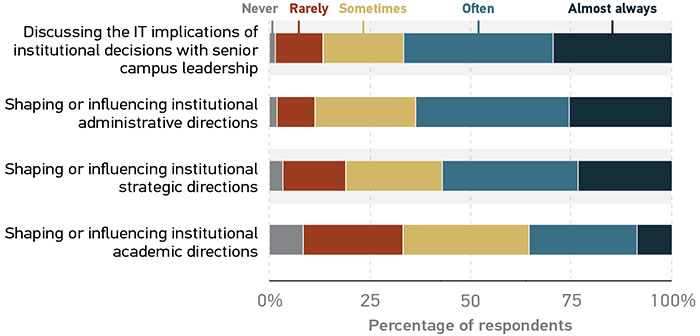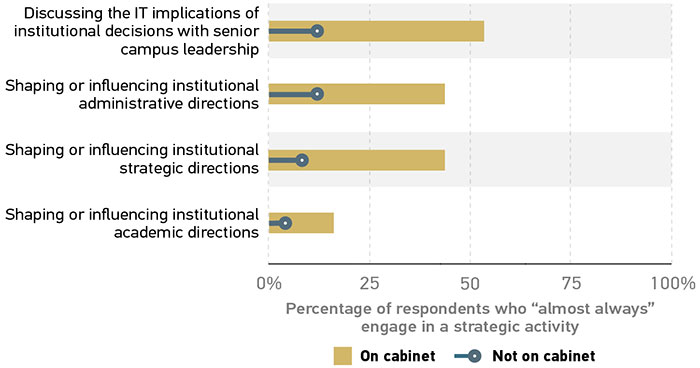Strategic Activities
While the main job of CIOs is to oversee the operations and management of the IT services and operations for their institution, their role as a member of the C-suite dictates that CIOs should also be engaged in strategic conversations and decision-making processes about the future of the institution. And EDUCAUSE has long recognized the strategic value and importance of information technology to higher education and has been advocating for a broader recognition and acceptance of IT as a strategic partner.1 But what empirical evidence can be brought to bear about the actual strategic impact the CIO has that will convince institutional leadership of IT's strategic importance and open a seat on the cabinet for the CIO?
The good news is that a majority of CIOs already see themselves engaged in major strategic activities on their campuses (figure 5). A full two-thirds of CIOs reported that they discuss the IT implications of institutional decisions with senior leadership often (37%) or almost always (30%). A similar percentage (63%) of CIOs said that they often or almost always shape or influence the administrative directions of their institutions. Slightly fewer CIOs, but still a majority (57%), are at least often engaged with shaping or influencing the strategic directions of their institutions. When it comes to shaping or influencing the academic directions of the institutions, only about a third (36%) are involved often to almost always, a percentage that is counterbalanced by the 33% of CIOs who said that they are rarely to never involved in these endeavors. So while there is room for CIOs to step up their game (or for the institution to allow the CIO on the court), there is a critical mass of trailblazing CIOs who are already playing the strategic game and might be in a position to mentor CIOs who aspire to expand their strategic purview of their roles.

But there is a clear and highly significant difference in the frequency with which CIOs who hold cabinet-level positions engaged in strategic activities compared with those who do not (figure 6). In fact, the magnitude of these differences is staggering. Compared with CIOs without cabinet posts, CIOs on presidential or chancellorial cabinets are:
- Over four times as likely to almost always discuss the implications of institutional decisions with senior campus leadership
- Over three times as likely to almost always shape or influence institutional administrative directions
- Over five times as likely to almost always shape or influence institutional strategic directions
- Over four times as likely to almost always shape or influence institutional academic directions
Conversely, CIOs without cabinet-level positions say they rarely to never exert strategic influence: for example, they range from 3 times more often than CIOs who sit on the cabinet to say they never discuss the implications of institutional decisions, to 9.5 times more often to say they never discuss institutional administrative directions with senior campus leadership.

Note
-
O'Brien, "IT: The New Strategic Imperative," and O'Brien, "Strategic IT: What Got Us Here."
↩︎